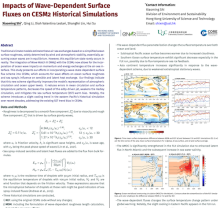The Impact of Wave-State Dependency on CESM2 Climate Simulation
Xiaoming
Shi
Hong Kong University of Science and Technology
Poster
The ocean governs climate processes by determining the atmosphere's momentum, heat, and water vapor budgets. Traditional climate models compute those exchanges across the air-sea interface by assuming an ocean surface with roughness uniquely determined by atmospheric wind and stability conditions, essentially equivalent to assuming ocean waves are in equilibrium states. In reality, waves are rarely in such equilibrium, and accurate representation of them requires a WAVE model. Such transient wave models have been emphasized in numerical weather predictions, especially for weather systems like tropical cyclones where strong winds occur. However, how introducing a wave-state dependency on sea-surface fluxes may improve climate simulations has yet to be thoroughly investigated. In this presentation, we report the progress of our work in implementing a wave-state-dependent surface flux scheme in the Community Earth System Model (CESM2). Our scheme considers the effects of waves on ocean surface roughness and those of sea spray on air-sea exchange of sensible and latent heat. We found that the new scheme significantly impacts the mean atmospheric circulation and the upper levels of the ocean. The error in mean circulation and surface temperature patterns are reduced. The modified surface flux lowers the eddy-driven jet speed and reduces eddy kinetic energy in extratropical cyclones. Sea surface temperature (SST) warm bias is reduced due to changes in surface flux and cloud-radiative feedback. In particular, the eastern Pacific exhibits cooling in the historical simulation for the recent decades with the new wave-dependent scheme, correcting existing SST bias in CESM2.

Poster file
shi-xiaoming-confronting-poster.pdf
(12.47 MB)
